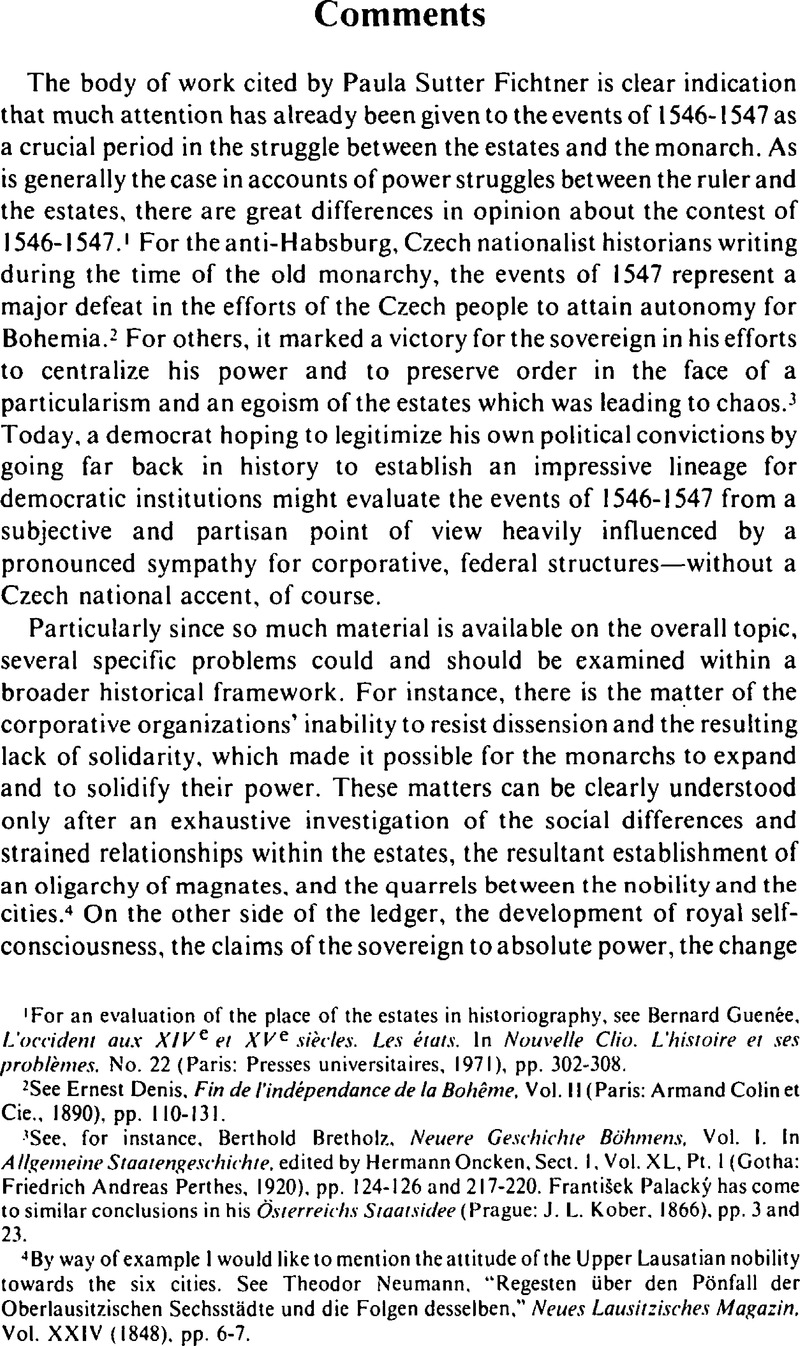No CrossRef data available.
Article contents
Comments
Published online by Cambridge University Press: 10 February 2009
Abstract

Information
- Type
- Habsburg Relations with Bohemia in the Sixteenth Century
- Information
- Copyright
- Copyright © Center for Austrian Studies, University of Minnesota 1975
References
1 For an evaluation of the place of the estates in historiography, see Guenée, Bernard. L'accident aux XIVe et XVe siècles. Les états. In Nouvelle Clio. L'histoire et ses prohlèmes. No. 22 (Paris: Presses universitaires, 1971), pp. 302–308.Google Scholar
2 See Denis, Ernest. Fin de I'indépendance de la Bohême. Vol. II (Paris: Armand Colin et Cie., 1890), pp. 110–131.Google Scholar
3 See. for instance. Bretholz, Berthold, Neuere Geschichte Böhmens, Vol. I. In AllgemeineStaatengeschichte. edited by Oncken, Hermann, Sect. I, Vol. XL, Pt. 1 (Gotha: Friedrich Andreas Perthes, 1920). pp. 124–126 and 217–220Google Scholar. Palacký, Franti⋅ek has come to similar conclusions in his Ösierreichs Siaatsidee (Prague: J. L. Kober. 1866). pp. 3 and 23.Google Scholar
4 By way of example I would like to mention the attitude of the Upper Lausatian nobility towards the six cities. See Neumann, Theodor. “Regesten über den Pönfall der Oberlausiuischen Sechsstädte und die Folgen desselben,” Neues Lausitzisches Magazin. Vol. XXIV (1848). pp. 6–7.Google Scholar
5 Lutz, Heinrich presents an interesting point of departure for investigating the changes in the system of values in his article on “Normen und gesellschaftlicher Wandel zwischen Renaissance und Revolution—Differenzierung und Säkularisierung,” Saeculum. Jahrbuch für Universalgeschichte, Vol. XXVI (1975), pp. 166–180.Google Scholar
6 Emperor Ferdinand to his sister Maria, Budweis. January 17, 1530, Bauer, Wilhelm and Lacroix, Robert (eds.), Die Kurrespundenz Ferdinands I., Vol. II, Pt. 2. In Veröffentlichungen der Kommission für Neuere Geschichle Öslerreichs, No. 31 (Vienna: Adolf Holzhausens Nachf., 1938). pp. 567–569.Google Scholar
7 This was similar to the game played by Lord Palmerston in the 1860's by conjuring up a fear of Napoleonic aggression.
8 Thus Horst Rabe could largely disregard what happened in Bohemia in his introductory sketch on the Schmalkaldic Wars, since Bohemian events had very little to do with developments in the empire after 1547. See his Reichsbund und Interim. Die Verfassungs- und Religionspolitik Karls V. und der Reichstag von Augsburg 1547/1548 (Vienna: Böhlau Verlag, 1971). In this connection it is especially important to examine Moritz von Sachsen's political policies and practices. Of course, it should be noted that while in one instance it was a question of imperial estates it was one of provincial estates in the other.Google Scholar

